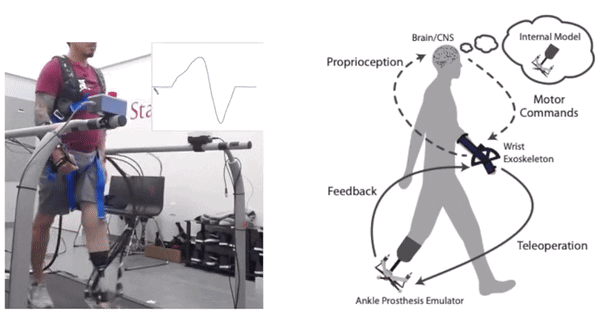
Individuals with lower-limb amputation lack direct control and typical sensory feedback mechanisms of the lost limb. This work aims to mimic these missing pathways by developing a system that allows someone with an amputation to teleoperate their ankle-foot prosthesis while receiving augmented sensory feedback. To achieve this goal, we present a novel wrist exoskeleton with the ability to accurately sense wrist angle and apply up to 1 Nm of wrist flexion and extension torque. Two control schemes allow the user to dictate ankle prosthesis behavior with the wrist in different ways: (1) the ankle prosthesis tracks scaled wrist angle at all times, while scaled ankle torque can also be applied at the wrist, and (2) the ankle prosthesis nominally behaves as a passive spring, and the user can inject or remove torque at any time during stance by moving their wrist against virtual springs implemented in the exoskeleton that are centered around a neutral wrist angle.
We implemented static and dynamic benchtop testing to ensure accuracy better than human perception for all system components. To assess feasibility and accuracy during gait, we conducted an experiment in which one participant with a transtibial amputation walked on a treadmill while using the wrist exoskeleton to control his ankle-foot prosthesis. To determine how accurately he could apply desired wrist trajectories while walking, we asked him to track multiple trajectories displayed on a screen in front of him. After one day of training, he was able to follow these trajectories with an average RMS error of 1.55°. We also demonstrated that the ankle prosthesis tracked commanded trajectories with accuracy better than human perceptual thresholds for both control schemes during walking. This novel system opens the door for investigations of scientific questions regarding human sensorimotor control, as well as translational outcomes for individuals with amputation.
